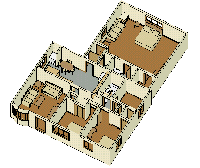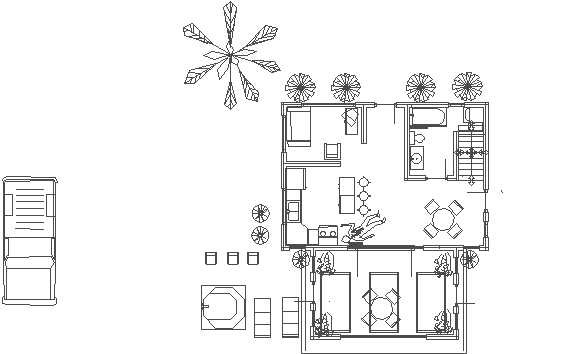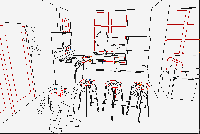CRIME SCENE SKETCHING
by
M/Sgt Hayden B. Baldwin, Retired
THE COURSE
A two day crime scene sketching course has been designed to meet
the needs of the law enforcement agencies. This course takes the students
from a rough skecth; to final drawings; to computerized drawings; to an
overview of 3D video animations. This is a hands on class. The students
will be required to complete all phases of the sketching. The instruction
method is by slide presentation, video animation tapes, and power point
presentation. The students will have hands on and if the course location
permits, the students will be able to use several different computer drawing
programs.
THE PAPER
It can be very difficult to describe the layout of
an area, building or even a single room to someone. However, with the use
of a sketch it becomes much easier to describe and understand the floor
plan. The prosecuting attorney may use a sketch to demonstrate to the jury
the layout of the building. They may ask the witness to indicate on the
diagram exactly where he was when he heard the gunshot. This method of
demonstrative evidence can far easier explain to the jury what happened
and where it happened. The rough sketch that was completed by the crime
scene investigator is for the preparation of a finished diagram to be used
in a court presentation. The investigator may draw a rough sketch of a
scene to aid in their investigation by recording certain important facts
that are difficult to put into words.
The seriousness and type of crime will
usually be the determining factor as to whether a crime scene sketch is
completed. A simple theft of a bicycle from a rear yard of a residence
may not indicate the need for a sketch. However, all homicides and other
crimes against persons will require a sketch of the scene.
A crime scene sketch can demonstrate a
true and accurate relationship between objects or the size of the objects.
This may be especially true in a fatal hit & run traffic accident.
The skid marks on the roadway may appear to be much longer in a photograph
than in real life. In a diagram they are accurately depicted and viewed
in perspective to the scene. Whether the scene is an outdoor homicide,
traffic accident, or an inside crime scene the relationship between objects
can be accurately illustrated.
Crime scene sketches should be considered
as crime scene photography is....general, intermediate and close up. In
crime scene sketches they are usually considered as an area drawing, single
building and a detailed drawing of a room. Outdoors, the sketches would
follow the same protocol, general area, intermediate and a detailed close-up.
It has been well established in court that
a well drawn diagram is an aid to the judge, jury and witnesses in visualizing
the crime scene. Their admissibility usually lies in their relevance and
accuracy. This type of evidence may be referred to as illustrative or demonstrative
evidence. Even poorly drawn sketches have been admitted into evidence,
as long as they are shown to be fair representations of the scene and it's
surroundings.
Rough sketches made at the scene should
be done in pencil so that corrections can be made easily. The scale
used is usually determined by the size of paper being used to draw upon.
The scale at this point is not important. Always fill the size of the paper
with the sketch, it will soon be cluttered with all the measurements or
objects. Try to keep the sketch in its proper proportion. If there is a
large number of items to be measured than the sketcher should list the
measurements on a separate sheet of paper.
All the equipment that you will need to
complete a rough sketch is a piece of paper, pencil, and a measuring device.
All finished sketches start with accurate data or measurements. Whether
you anticipate a finished two dimensional drawing or an elaborate 3D video
animation of the scene, they all start with an accurately measured rough
sketch.
There are three methods of measurement to accurately
measure the location of an object. These methods are the rectangular (right
angle), triangular, and the base line method. The rectangular method simply
uses a right angle (90 degree) from a given flat surface (wall of a structure)
to find the distance to the object. Two measurements are required. The
triangulation method uses a permanent object, coroners of a room and measure
from there to the object, two points are required. The last method, baseline,
is usually used in a large outdoor setting. A straight line is marked between
two fairly permanent objects (fireplug & a telephone pole) and 90 degree
measurements are made of the baseline to the object. In most instances
we think of sketches as two dimensional, however we need to remember that
space is considered as x, y, & z coordinates. In other words we need
to measure the height or depth of objects. This can be illustrated by bullet
holes in a wall, or marks on a piece of furniture. For instance, blood
spatter interpretation is usually considered as x, y, & z. These same
coordinates are measured as previously described.
For crime scene sketching equipment I would suggest
the field investigator use 4 square graph paper (4 squares to an inch),
a disposable pencil with an eraser, a straight edge (good 12 inch plastic
ruler), a compass for the direction of North, and a 25 foot steel retractable
measuring tape. To carry all these objects use an oversize aluminum clip
board with a storage compartment. Remember, the persons doing the sketches
need to be concerned with bio-hazards at the scene too. They require equipment
that can be thrown away if contaminated with bodily fluids or decontaminated
with a 10% solution of bleach and water.
The drawing or sketch is broken down into
four parts.....the body, title block, north arrow, and the legend. The
body of the drawing is where the sketch is drawn. The title block is normally
in the lower right corner and contains the Case number, the date the drawing
was completed, the location of the sketch and the name of the sketcher.
This is the minimum information required but the title block can include
additional information depending on local protocol or needs of the agency.
The north arrow normally points up on the paper and the drawing usually
is positioned to reflect this ...... I prefer to have the point of entry
to the structure or site at the bottom of the paper and let north fall
where it may. I do this because it is easier for the witnesses who have
entered the structure to orient themselves on the stand when testifying.
The last portion of the sketch is the legend. Some agencies have a dual
legend, one identifies the objects by alpha designators....i.e., A=Couch,
the other legend identifies the evidence, usually by the evidence number.
I prefer to use a single legend to identify the location of the evidence.
All our drawings are marked "Not to Scale" because
they are not 100% to scale. Our sketches are measured to within 1/4" of
accuracy, whether it is an indoor scene or a large outdoor scene. Some
defense attorneys want to argue over the width of a line on the drawing
or the inaccurate "metal" measuring tool that can possibly expand or contract
depending on the heat or cold. This expansion is minimum and would not
be a concern of the investigator.
Ok, we have addressed the reason for a
sketch, the need for accurate measurements and the equipment required.
Now how do we complete the finished sketch? The finish sketch is rarely
completed at the scene. The finished sketch requires some artistic skills
and may beyond the ability of the person completing the rough sketch. The
drawing equipment is a fine mechanical pencil, rubber eraser, triangles,
compasses, templates for numbers and text, a large drawing board and t-square.......and
a lot of patience! The finished drawing is converted to a scale that is
reasonable for the display media for court presentation, normally about
3' by 4 '. While this method of completing a finished drawing has been
used for years it is now obsolete, or nearly so.
The advent of the computer changed the way we
complete a finished drawing. Now even those who can't draw a straight line
can operate a mouse and create a high quality finished drawing in a short
time. Several drawing programs have hit the market that allows the investigator
to complete a simple two dimensional drawing, all the way to a complicated
three dimensional crime scene illustration...........even to full video
animation! The technology is here!
Click on images to see a full screen image.
Crime Scene Sketching Programs
The
Cad Zone
Sirchie
SmartDraw
3Deyewitness
AutoCad
Click here to ask for
additional information or to send comments.
HOMEPAGE





